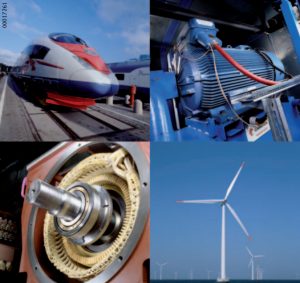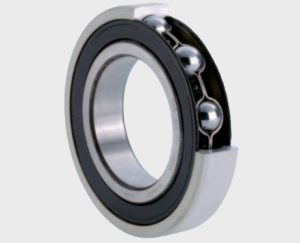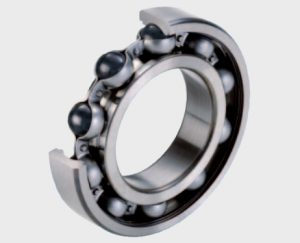

Wheelsets and traction motors (rail vehicles), DC and AC motors (drivetrains), and generators (wind power) can all be exposed to electric current—which can be extremely harmful to roller bearings.
While it is very difficult to eliminate the causes of bearing voltages that are induced by the motor, it is possible to avoid bearing damage with insulated components that prevent or significantly reduce the flow of current. That’s where current-insulated bearings come in—the roller bearings that offer protection against current passage.
Why Use Current-Insulated Roller Bearings?
Electric currents can cause damage to the raceways and rolling elements of a bearing, as well as degradation of the lubricant. This, in turn, can cause the motor or generator to fail prematurely and unexpectedly.
In addition to repair expenses, machine downtime and production losses are incurred, racking up costs even further. By reducing maintenance and repair costs, and increasing machine availability, current-insulated bearings can significantly increase the value of your operations.
Factors To Consider When Selecting Current-Insulated Bearings
FAG, by The Schaeffler Group, offers various current-insulated roller bearing options, but there are a few major factors to consider when selecting the right insulated components for your application.
For example, determining which components need to be insulated is dependent on the type of voltages occurring. There are two main types of voltage:
- Induced Voltage Along The Shaft: This produces a circular current, which is closed via bearing one, the housing, and bearing two. Such shaft voltages are often the result of an asymmetrical distribution of the magnetic flux within the motor. This is especially evident in motors with only a few pairs of poles. If this is the case, it is sufficient to disrupt the flow of current by insulating one of the two bearings.
- Voltage Between The Shaft and The Housing: In this case, electric currents flow through each of the two bearings in the same direction. The most likely cause is the converters’ common-mode voltage. This type of situation might require insulating both bearings.
Additionally, because a current-insulated bearing acts like a resistor and capacitor connected in parallel, it is important to consider the time response of the given voltages. To ensure good insulation, the ohmic resistance should be as high as possible, and the capacitance should be as low as possible.
Ceramic-Coated Bearings vs. Hybrid Bearings
Another main component of current-insulated bearings is understanding and choosing between the two major types of bearing insulation available—ceramic-coated and hybrid bearings.


Ceramic-Coated Bearings
Ceramic-Coated Bearings undergo a plasma spray procedure where an oxide layer is applied and sealed to either the inner ring or outer ring of the bearing, providing insulation against current passage. The bearing surfaces of the rings must be cylindrical and uninterrupted by lubrication holes or grooves.
FAG ceramic-coated bearings have a few key advantages over hybrid bearings:
- Oxide ceramic coatings provide a high level of insulation.
- Thanks to a special sealant, the J20AA coating retains its insulating properties even in a damp environment. The resulting oxide ceramic coating is very hard, wear-resistant, and a good thermal conductor.
- The external dimensions of the current-insulated roller bearings are in accordance with DIN 616 (ISO 15). This means that they are interchangeable with standard bearings.


Hybrid Bearings
Hybrid Bearings are made from rolling bearing steel, and the rolling elements are made from ceramic. In this case, the rolling elements are extremely resistant to wear and perform the function of current insulation. Hybrid bearings are available as both ball bearings and cylindrical roller bearings.
FAG hybrid bearings have a few key advantages over ceramic bearings:
- Hybrid bearings offer very high resistance to current passage. Their direct current voltage resistance, even at high temperatures, is in the G-range. A typical value for capacitance is 40 pF and is thus lower by a factor of 100 than bearings with ceramic coating.
- Hybrid bearings allow higher speeds at lower friction and, thus, lower temperatures in operation.
- Hybrid bearings have better emergency running characteristics than standard bearings.
If your applications are exposed to electric currents during operation, current-insulated bearings offer a proactive and economical solution, saving you downtime and money over time.
Interested in learning more about current-insulated bearings? Contact our bearing experts – or give us a call at 913-677-3151 – to learn more about FAG current-insulated roller bearings and how they can help you prevent bearing damage from current passage.





